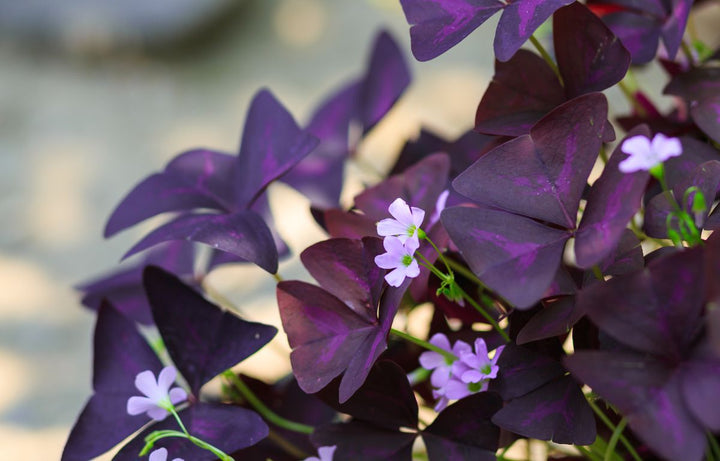
Plant Profile: Oxalis Triangularis or False Shamrock
Plant Profile: Oxalis Triangularis or False Shamrock
In the realm of indoor gardening, the Oxalis Triangularis, colloquially known as the False Shamrock or Purple Shamrock, has captured the admiration of numerous plant enthusiasts. With its enchanting appearance, intriguing foliage, dim light tolerance, and relatively straightforward care requirements, it has become a favourite for adding a pop of colour to the homes and gardens of houseplant enthusiasts around the world.

The Oxalis Triangularis hails from Brazil, specifically from the rainforests of South America. Like the Peace Lily, Oxalis Triangularis’ is a low-growing species that flourish on the forest floor and is naturally sheltered by larger flora that provides dappled sunlight. Given the plants, preference for indirect natural sunlight, it is perfect for indoor cultivation, especially for spaces that have dim lighting.
Oxalis Triangularis is phototropic meaning that the plant moves in response to the sun and will open or close its leaves depending on the amount of light it is receiving. In addition, the deep purple or maroon foliage colouring is due to naturally occurring anthocyanin pigments. More pigments are produced in response to brighter light. When light levels are reduced, the plant produces fewer anthocyanins, resulting in a greener appearance. This is in no way harmful to the plant and is in fact, a way for it to conserve and focus energy into growth.
Growing Oxalis Triangularis
Light: Oxalis Triangularis can tolerate and even thrive in relatively low or dim natural light conditions due to its natural light-sensitive adaptation, making it a suitable choice for indoor spaces with limited sunlight. However, for optimal growth and flowering, position your plant in a well-lit area with indirect sunlight. Avoid excessive direct sunlight as this can easily dry and burn the plant’s delicate leaves.
Watering: Keep the soil evenly moist throughout the growing season, which typically occurs in spring and summer. Water the plant when the top couple of centimetres of soil feels dry to the touch. Water thoroughly, allowing excess water to drain from the pot to avoid root rot. Make sure to water the plant at the base and avoid wetting the foliage, as wet leaves can make the plant susceptible to fungal diseases. During the plant's dormant period, which typically occurs in autumn and winter, reduce watering.
Soil and Potting: Plant your Oxalis Triangularis in a well-draining premium potting mix, or a mix that includes a mixture of peat moss and perlite. Opt for a shallow pot since this plant boasts a shallow root system. However, be mindful that it must also have room for the roots to expand as the plant matures.
Temperature and Humidity: Keep your Oxalis Triangularis in temperatures ranging from 15-24°C with a humidity level between 40-60%. Maintaining proper humidity levels around the plant can also help keep the soil from drying out too quickly. If your indoor air is particularly dry, consider using a misting spray bottle, humidity tray or a room humidifier to create a more favourable environment.
Fertilisation: Adequate nutrients enable the Oxalis Triangulairs to produce new leaves, and stems, enhancing its overall appearance and vitality, and promoting greater anthocyanin pigment production and even flowering. Feed your plant every 4-6 weeks during the growing season (spring and summer) with a balanced liquid fertiliser diluted to half strength. Reduce fertilisation during the plant’s dormant period (late autumn and winter).

Common Problems and Solutions
Leaf Drooping: If you observe the leaves of your Oxalis Triangularis drooping, it may indicate under-watering or you are waiting too long in between watering periods. Ensure a consistent watering schedule while avoiding over-watering. Increase the watering frequency during the growing season and decrease it in the dormant period.
Yellowing Leaves: Yellowing leaves may signal excessive watering or inadequate drainage. Adjust your watering routine and guarantee that your pot includes drainage holes to prevent waterlogged soil. The best way of checking the soil’s moisture consistency is to poke your finger or a gardening tool into the top few centimetres. If the subsoil feels wet, then you are likely overwatering your Oxalis Triangularis. Mix in dry potting soil to soak up the excess moisture or wait until the soil dries out completely before watering again.
Pests: On occasion, aphids, mealybugs, or spider mites may infest your plant. Treat the affected plant with neem oil or organic insecticide and isolate it from other plants to prevent the infestation from spreading. Cut away infected parts of the plant if needed.
Dormancy: Oxalis Triangularis undergoes a natural dormancy period during winter when it may appear to be wilting or even die back. Prune away dying foliage, reduce watering and allow the plant to rest during this period. This resting period promotes new and more abundant growth come spring.
Leggy Growth and Not Flowering: If your Oxalis Triangularis becomes tall and leggy, it may require more natural light. Relocate the plant to a brighter spot and trim back old or lengthy stems to encourage healthier and bushier foliage growth. During its growing cycle, increased natural light should also promote flowering in more mature Oxalis Triangularis plants. Lastly, consider increasing the fertilisation frequency of your plant.
The Oxalis Triangularis or False Shamrock is an endearing alternative to the usual greenery of houseplants. With suitable natural lighting, adequate watering and the right amount of fertilisation, this easy-maintenance plant is sure to stand out as a plant favourite for years to come.
